 |
| |
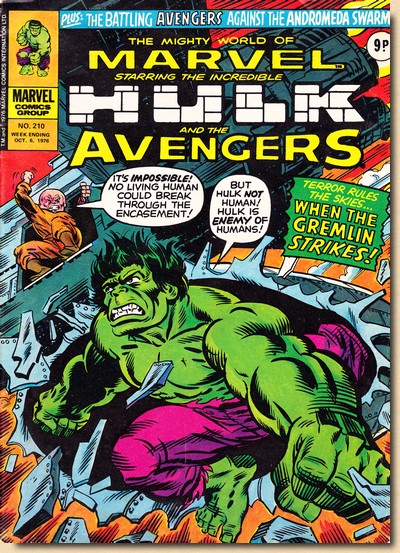 |
|
MARVEL
UK
INSIDE
THE
MIGHTY WORLD OF MARVEL #210
OCTOBER
1976

|
|
| |
| |
| Marvel launched its own UK
imprint operation in late September 1972 with a comic
book which would become both its flagship title and its
publication credo and motto: the Mighty
World of Marvel. Edited in the US under the
supervision of Tony Isabella but printed in the UK to a
larger format than American Marvel comic books, the 40
page Mighty World of Marvel #1 kicked off a row
of highly successful years for what would soon be known
as "Marvel UK".
Reprinting the House of Ideas' classic material from the
very beginnings and in chronological order, Mighty
World of Marvel - or MWOM, as it was also
affectionately referred to by fans - started out with the
origin stories of the Hulk, the Fantastic Four and
Spider-Man. The latter two would soon move to their own
or other Marvel UK titles, but the Hulk would remain on
board for the entire run of no less than 329 issues
before Mighty World of Marvel simply became Marvel
in January 1979.
The UK
comic book market of the 1970s differed greatly from its
counterpart in the US as it was quintessentially keyed at
a weekly interval of publication, with predominantly
black and white contents and multiple storylines (and
therefore often also various different characters) in one
issue. Marvel UK followed this formula to a T, and MWOM
therefore always featured multiple (and sometimes very
diverse) reprint material in one issue. In fact, by 1976 Mighty
World of Marvel was host to no less than four Marvel
A-list characters: the Hulk, the Avengers, Conan, and
Daredevil.
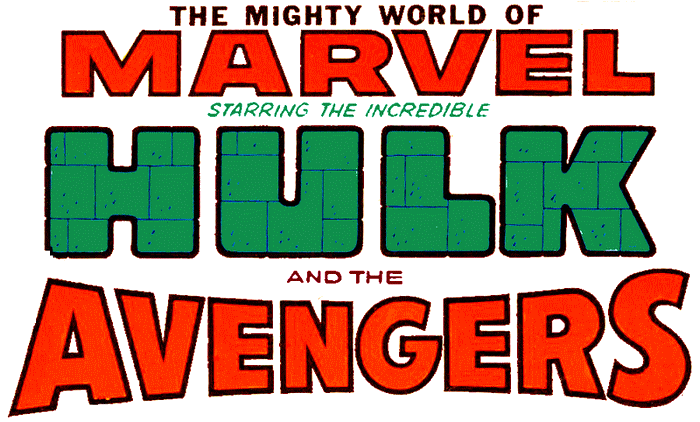
So let's take a closer look at
the black and white content behind the glossy cover of Mighty
World of Marvel #210, which went on sale in the UK
the first week of October 1976.
|
| |
|
| |

"There's a
Gremlin in the Works!"
Originally
published in Incredible Hulk #187
(May 1975)
Script -
Len Wein
Pencils - Herb Trimpe
Inks - Joe Staton
Lettering - Artie Simek
Original page count: 18
Reprinted pages:9
|
|
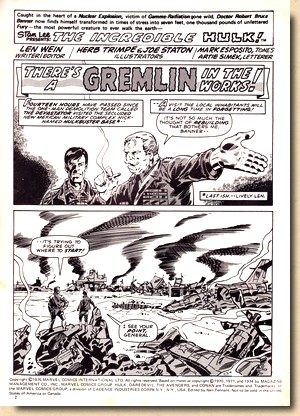
|
|
|
| |
| The
weekly publication schedule and the use
of multiple characters and storylines for
Marvel UK's output required serialization
of the original material, i.e. a
storyline published in one US issue at
the time would be spread out over several
issues of a Marvel UK title. Starting out by
reprinting the beginning of an original
US issue was, obviously, the easiest way
for Marvel UK editorial to handle things.
This was the case with the Hulk feature
in Mighty World of Marvel #210,
which therefore kicks off with the
original splash page and story title -
with a slight alteration. Taking into
account the lack of colour in its reprint
format, the splash page of MWOM #210
dropped the colourist's credit for Glynis
Wein and replaced this with crediting
Mike Espositio for "tones".
Marvel's green
gamma-ray growler became the unofficial
lead character of MWOM very early on, not
the least thanks to the Hulk's immense
popularity with UK readers, and therefore
often received star billing and the first
pages of many issues of Mighty World
of Marvel.
The original
mid-1970s material reprinted at the time
had a page count of 18 per US issue,
which generally resulted in 9 pages of
Hulk per issue of MWOM, i.e. the original
material was cut in half.
The need for serialization caused by
British comic book market habits
effectively required Marvel to put in a
substantial amount of extra work to meet
the need for new covers and splashpages
(where the UK
reprint actually consisted of the second
or even third half of an original issue).
|
|
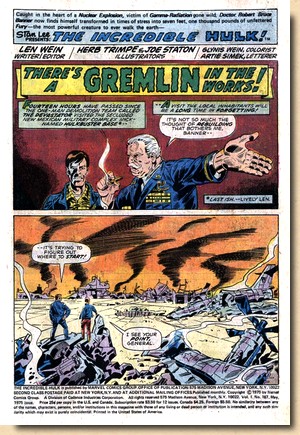
|
|
|
| |
| But more troublesome than this were the
headaches caused by the fact that the British
reprints were catching up on the original
material at a frightful speed. |
|
| |
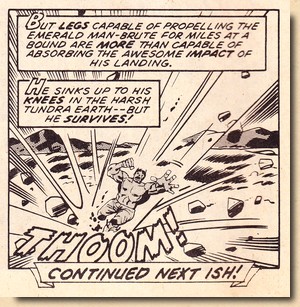
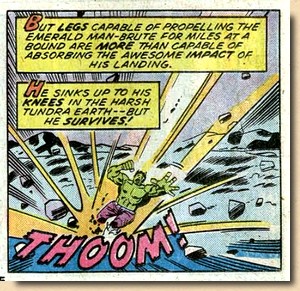
|
|
The
calculation was an easy one: reprint half of an
original issue per week and you end up using the
output of two months in the US for one single
month in the UK. Not a real worry at the outset
of operations, this almost inevitable modus
operandi clearly became worse in an
exponential way over time. In the case of Incredible
Hulk, MWOM was already reprinting US
material from May 1975 by the beginning of
October 1976. Even cutting down to a
serialization in three parts of six pages
couldn't bring things into sync, only marginally
slow down the pursuit. The story is a standard
mid-Bronze Age Hulk story which starts out as Bruce
Banner and General Thunderbolt Ross gaze at the
aftermath of the complete destruction of the
"Hulkbuster" base by the Devastator
(events which took place in the previous US
issue). Ross is nevertheless upbeat because
Banner has not turned into the Hulk since, a sign
of him being able to control the transformation
process at least at times.
The two then meet with Betty Ross, Nick Fury
and Clay Quartermain and discuss the plans to
free Glenn Talbot from a Soviet Siberian fortress
codenamed "Bitterfrost". Told the next
day that he cannot accompany the rescue team,
Banner plans to stowaway and thus hides into the
rear of the plane near the weapons pod as he
wants to help Betty be rejoined with her husband.
Once airborne, the plane is soon spotted by
the Gremlin, a Soviet villain scientist who
attacks it. The plane tries to evade the missiles
fired by the Gremlin and the pilot decides to
drop its weapons pod in order to gain height and
speed - which means that Banner is ejected with
it. Knowing that his only hope of survival is a
transformation into the Hulk, Banner wills about
the change and turns into the "emerald
man-brute" just as the pod hits Soviet soil
and is utterly destroyed. The Hulk, however,
survives without a scratch... - CONTINUED
NEXT ISH!, as the small editorial paste-up
proclaims.
The serialization sometimes also had other
side effects - such as, in this case, leaving the
UK reader with 9 pages of a Hulk story in which
only the last three panels actually depict the
Green Goliath. But then the glossy colour cover
(possibly by Pablo Marcos) in a way made up for
this.
|
|
| |
| The Hulk installment is followed by a Bullpen
Bulletin page (more on this later on) after which MWOM
#210 continues with the second Marvel feature billed on
its cover - the Avengers. |
| |
|
| |

"A Vision of
Madness!"
Originally
published in Avengers #96 (February
1972)
Original story title: "The
Andromeda Swarm!"
Script -
Roy Thomas
Pencils - Neal Adams
Inks - Neal Adams, Tom Palmer
& Alan Weiss
Lettering - Sam Rosen
Original page count: 20
Reprinted pages: 5 (plus Marvel UK splash
page)
|
|
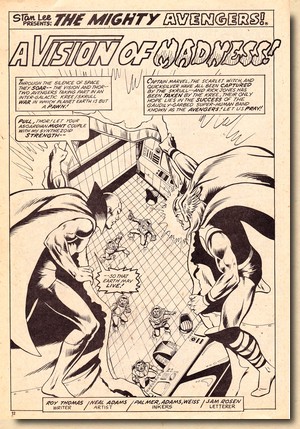
|
|
|
| |
| Starting
out with one of the many extra splash
pages produced by Marvel's NYC staff for
Marvel UK, this example (based on the
last panel reprinted in MWOM's previous
issue) illustrates how these pages were
not only needed to avoid an all too
abrupt entry for readers into what was in
fact a mere segment of an original flow
of events, but also to provide a recap of
"the story so far". This was
also important for original material
which was serialized into short segments
in order to ensure that readers didn't
lose sight of what was going on from one
week to the other. |
|
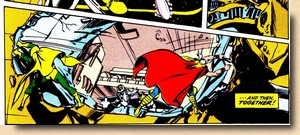
|
|
|
| |
| This was especially true for
the Avengers material reprinted in MWOM during the autumn
of 1976, which was the classic milestone Kree-Skrull
War - a story arc written by Roy Thomas and
pencilled by Neal Adams, Sal Buscema and John Buscema
which itself ran for an entire nine issues when
originally published in Avengers #89-97 (June 1971
to March 1972). |
| |
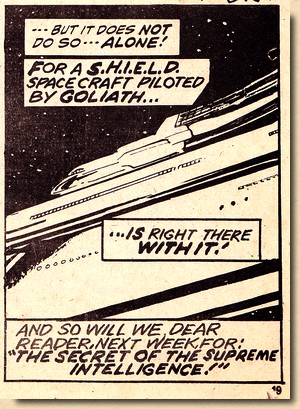
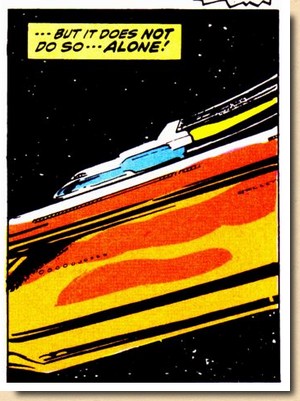
|
|
Whilst serializing this
saga into weekly segments of five pages
neutralized the aforementioned problem of
catching up with the original material,
it potentially made following this
specific story in a coherent way a very
difficult task as the Kree-Skrull War
is commonly noted (and praised) for its
almost Shakespearean portrayal of an
interstellar warfare with an enormous
cast of characters and frequent use of
metaphor and allegory.
"Running nine issues,
much of it spectacularly illustrated
by Neal Adams, the Kree-Skrull War
had no precedent in comics." (Sanderson,
1998)
Editor Neil Tennant (of later Pet Shop
Boys fame), in charge of Mighty World
of Marvel at the time, was conscious
of the complexity of this particular
story arc and tried to prevent readers
from slipping. Firstly, by providing
detailed recaps on the additional splash
pages, and secondly by adding information
which was absent from the original in
order to provide UK readers with a
cliffhanger which made sense (when in the
original material the story continued
right away on the next page).
An example of this can be seen in the
final panel of the Avengers installment
in MWOM #210, where editorial added
further exploratory text which made it
clear to readers what was happening in
this panel whilst at the same time
providing a heightened sense of suspense
leading into the next page (i.e. in this
case next week's installment).
Introduced in Mighty World of Marvel #46
(August 1973) the Avengers were promoted
to their own weekly UK mag only a month
later as Marvel UK expanded its range of
titles in a continuing wave of success.
But by 1976 the
British comic book market was harshly
overshadowed by a UK economy in a state
of trauma.
Following an
inflation rate which had climbed to 20+%
in 1975 (Wanninski, 1975), the value of
the British pound sterling began to slide
during the first quarter of 1976. By
September that year confidence in the
pound had virtually collapsed, and the
British government was forced to seek
help from the International Monetary
Fund. At the time, this was a measure
only seen used by third world countries,
and it would be a long time before it
would once again become a scenario
applicable to European countries such as
during the 2011/12 Euro crisis or the
near financial collapse of Greece in
2015. Back in 1976, the political crisis
in the wake of that economic downturn
left Britain in a state of gloom (Burk,
1992).
Marvel UK was forced to thin out its
line of titles, and as a result the
Avengers lost their own title in July
1976 after 148 issues - and found
themselves back in the pages of Mighty
World of Marvel again. The merger of
various Marvel weeklies resulted in a
rise from three to four features in one
title, leaving less pages for, in this
case, the Avengers than they had enjoyed
previously.
|
|
|
| |
| Things were starting to get a little cramped in
Marvel UK's titles in late 1976 - a fate also suffered by
the next feature in this issue of MWOM, Conan the
Barbarian, who had joined the Avengers in their move from
The Avengers to the pages of Mighty World of
Marvel when that title was cancelled.
Two pages
of readers' letters were slotted in between the cosmic
Kree-Skrull war and the sword & sorcery of Conan.
|
| |
|
| |
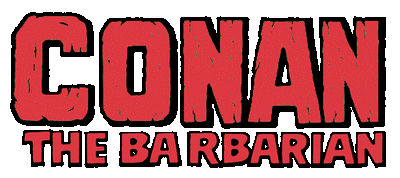
"Man
Born of Demon!"
Originally
published in Conan the Barbarian #51 (June
1975)
Script - Roy
Thomas
Pencils - John Buscema
Inks - Dick Giordano (figures)
/ Terry Austin (backgrounds)
Lettering - John Costanza
Original page count: 18
Reprinted pages: 6
|
|
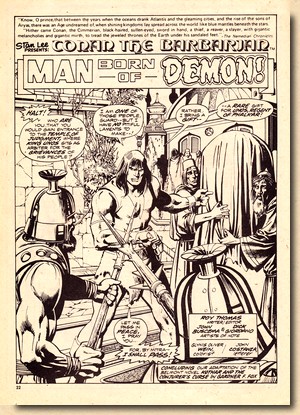
|
|
| |
| The Conan feature
reprinted in Mighty World of Marvel
#210 afforded the editorial staff the
same luxury as the Hulk installment,
namely the possibility to use an original
splashpage as is. In doing so Marvel UK
sometimes made an effort to adjust the
otherwise incongruous credits for
"colouring" (as on the Hulk
splashpage in this issue), and sometimes
they didn't - as can be seen here, where
Glynis Wein remains noted for a work
contribution purposely withheld from the
UK readers. As the splash page also
informs us, this is the final part of an
adaptation of Gardner F. Fox's novel Kothar
and the Conjurer's Curse - yes, that
is the prolific comic book
author who also was a prolific writer of
novels. Roy Thomas, on the other hand,
adapted the plots of several non-Conan
novels during his run on Conan the
Barbarian, simply changing the
original protagonist into Robert E.
Howard's fantasy king Conan but
otherwise sticking fairly close to the
original material. This was also the case
with Fox's Conjurer's Curse,
which Thomas turned into an adaptation
running for a half dozen issues, with Conan
the Barbarian #51 being the closing
part.
In MWOM #210, readers saw Conan show
up at the entrance to Unos's palace with
a covered cage, demanding to see the
regent to give him a gift. Pushing his
way into the palace, a seemingly bored
Unos allows him to speak, so the
Barbarian pulls the cover from a cage
which contains a bizarre magical talking
bird. The strange creature then proceeds
to disclose various events of treachery
and wizardry which have taken place
lately and which could also affect Unos -
whom the strange bird calls an unnatural
creation of demonic magic.
|
|
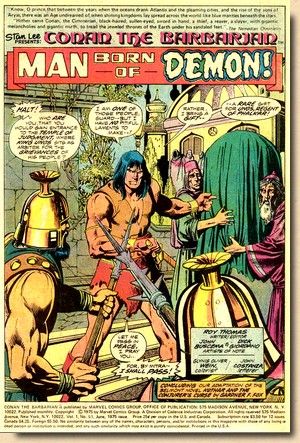
|
|
|
| |
| Conan and the bird then leave the castle, after which
the starnge creature turns back into the sorceress
Lipalina, and the two wait for the inevitable arrival of
Unos, seeking help in defeating the powerful wizards
plotting his death ... |
| |
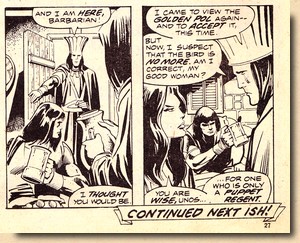 |
|
At this point, the installment
ends for this issue of MWOM, and the CONTINUED
NEXT ISH! banner indeed looks like a carbon copy
of the one used for the Hulk installment of that
very same issue. Marvel's
successful diversification of the Bronze Age into
genres such as sword & sorcery or horror had
been spearheaded in the US by the highly successful Conan
the Barbarian #1 in October 1970, ultimately
clocking up a staggering 275 issues before bowing
out in December 1993.
In the UK, however, his
own title (which
also introduced him to British readers) failed to
work up any magic: Savage Sword of Conan
was cancelled in July 1975 after a mere 18 issues
and only four months' presence on the newsstands.
The Barbarian was
immediately transfered to the pages of The
Avengers as of issue #95 in mid-July 1975,
at the cost of Dr Strange.
|
|
| |
| Merging features from cancelled titles into more
successful mags became standard practice for Marvel UK,
and with the difficulties the comic book industry faced
by mid-1976, some characters went on a merry-go-round as
more and more weekly titles were grounded and those which
soldiered on took up some of the shipwrecked Marvel
heroes. Following Conan's switch
to
The Avengers (which thereafter became The
Avengers and the Savage Sword of Conan), he once
again became homeless when the Avengers lost their own
weekly title in mid-July 1976. As a result, the Avengers
and Conan were both carried over into the pages of Mighty
World of Marvel - although Earth's mightiest heroes
only lasted for 13 issues of MWOM before being
moved once again (as of issue #212 in late October 1976),
this time to the pages of Super Spider-Man and the
Titans. It all showed just how unstable things had
become, and the line between enjoyable diversity and
chaotic discontinuity was becoming evidently thin. Conan
himself was dropped altogether from The Mighty World
of Marvel as of issue #220, but would resurface in The Savage Sword of Conan (vol.
2) #1 in November 1977 -
a publication set in a magazine format
with 52 pages and published monthly rather than weekly,
and clearly aimed at a more adult readership.
|
| |
|
| |
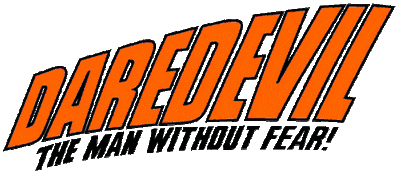
"A
Star is Born!"
Originally
published in Daredevil #67 (August
1970)
Original story title: "Stilt-Man
stalks the Soundstage"
Script - Gary
Friedrich (plot by Roy Thomas)
Pencils - Gene Colan
Inks - Sid Shores
Lettering - Artie Simek
Original page count: 20
Reprinted pages: 6 (plus Marvel UK splash page)
|
|
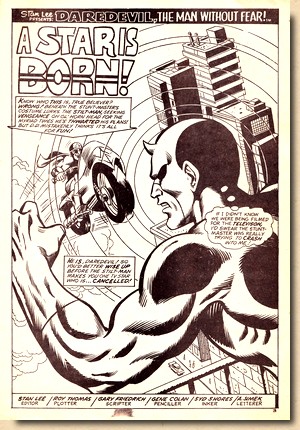
|
|
| |
| Daredevil, like the
Hulk, was always a regular feature of Mighty World of
Marvel ever since replacing Spider-Man (who
moved to his own title at the time) as of MWOM #20 (17
February 1973). Although he was given the occasional
cover appearance he never receiving top billing, but even
in the most tumultous times of Marvel UK's title mergers
and cancellations remained a solid part of MWOM.
|
| |
| MWOM #210 featured the
concluding six pages of Daredevil
#67 (and therefore also a Marvel UK
splashpage, in this case of disputable
quality), in which
Karen Page has
been offered a role on the new
Stunt-Master television series and gets
Daredevil to agree to appear in the pilot
episode. The climax presented here to
UK readers sees DD downing the Stilt-Man
(who disguises himself as Stunt-Master) -
and another terse moment between Ol'
Hornhead and his love interest.
|
|
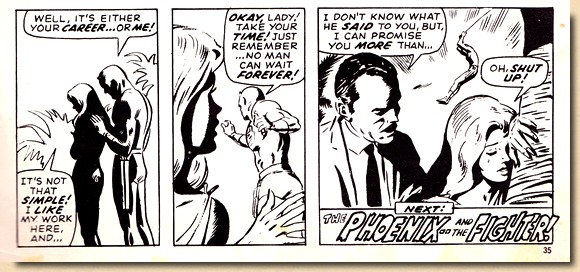 |
|
|
| |
| Still reprinting the classic Gene "the
Dean" Colan material from - depending how you look
at it - the very late Silver or very early Bronze Age,
there was nothing that could go wrong here once readers
were past the somewhat out of style splashpage especially
produced for this issue of MWOM. These were always
unpredictable and could go both ways as, rather
surprisingly (from a money making point of view) the
process of blowing up and turning single page panels into
splashpages seemed to be applied less and less by the
editorial staff at Marvel UK. |
| |
|
 |
|
| |
The single Bullpen Bulletin page (which however
carried no such title) gave readers "thrilling
thoughts to amaze and amuse" them - and focused
mainly on the imminent launch of Marvel's very first UK
superhero: Captain Britain.
"Next week is it, folks! Is what, you
ask? Why, the week of the newest, greatest sensation
from the fabulous House of Ideas, Captain
Britain!! We've hinted at it over
the past few weeks, but we've not even come close to
the excitement that awaits you in the latest,
greatest British Weekly!! Not only do we have a
brand-new, never-before-seen feature in the book
(namely one Captain Britain), but we also have -
colour! That's right, effendi, two - count 'em, two -
features in this fantabulous new title will be in
totally-titanic tones! Naturally, ole CB
will be in colour 'cause we want ya to get the full
impact of this new Claremont/Trimpe/Kida creation -
but we're also, for your enjoyment and edification,
using the same mind-boggling colour-process on the
fabulous Fantastic Four
feature which is moving over from The
Titans (unabashed plug!). If you
only plan on buying one Marvel mag next week - and
how could you even think of such a thing? - make it
the pulse-pounding premiere issue of Captain
Britain!! (a collector's item in
the making!)"
The powers in charge at Marvel's
NYC offices had come to the conclusion that the time was
right for some original content within Marvel UK's line
and turned out a character whose name said it all: Captain
Britain. - with more than obvious parallelisms to
Captain America. Captain Britain #1 hit the
newsagent stands a week after MWOM #210, on 13 October
1976, featuring an eight page colour story titled "The
origin of Captain Britain" penned by Chris
Claremont, drawn by Herb Trimpe, inked by Fred Kida, and
- yes indeed - coloured by Marie Severin.
|
| |
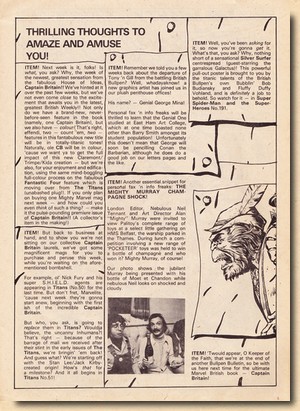 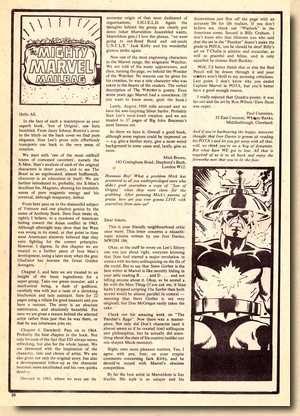 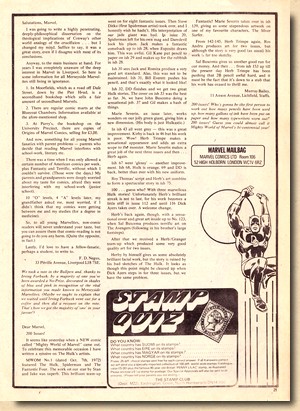 |
| |
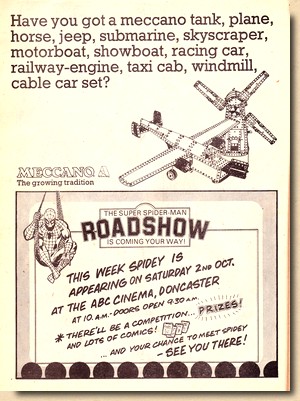
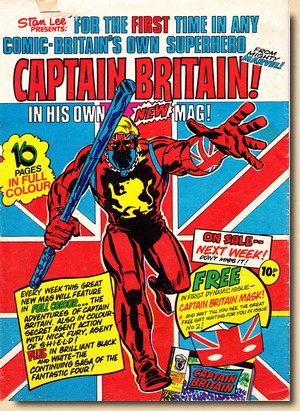
|
|
As a
sideline, the editorial shout-out also hints at
the previously mentioned many changes which
Marvel UK's weeklies saw in their line-ups, all
usually at very short notice, during 1975 and
1976. Apart from the usual commentaries
and banter on the likes and dislikes of readers
concerning characters, stories and art as well as
other readers' letters and points of view, the
letter pages of MWOM #210 also contains - rather
somewhat outside of the regular tone of these
pages - one reader's lengthy review of Stan Lee's
Son of Origins book, and another
reader's anecdotic memories on how his parents
and grandparents once feared that his comic book
reading would interfere with his education but
now see him getting a degree in medicine, whilst
a third reader ran through a nostalgic look back
over 200 issues of Mighty World of Marvel.
Inserted between the Conan and Daredevil
features was a semi-page third party
advertisement for regular advertiser Meccano,
providing some period flavour from today's
perspective, plus an also semi-page in-house
advertisement for the Super Spider-Man Roadshow
event in Doncaster.
And finally, the back cover in its full splash
of glorious colour advertised the brand-new
Marvel UK Weekly and its even brand-newer title
character: Captain Britain ("for the
first time in any comic - Britain's own
superhero") - in full colour.
Colour had been a wish
expressed in many fan letters ever since Marvel
UK launched its first weeklies, and it would
initially secure good sales figures for Captain
Britain. However, the novelty attraction
would wear off fairly soon as the overall quality
of the CB material left many readers rather
disappointed, and as a consequence the title
would be cancelled after 39 weekly issues in July
1977.

More on Marvel UK in 1976:
1975 - 1977
: EXPANSION, MERGERS - AND CAPTAIN BRITAIN !
|
|
| |
|
| |
EPILOGUE
MIGHTY
STILL FOR MANY YEARS
|
| |
| Marvel UK's presence on the
British comic book market during the Bronze Age period
was to a large extent tied to its first and flagship
title, Mighty World of Marvel. Since the
relaunch of the title as plain Marvel Comic in
January 1979, the label Mighty World of Marvel
had vanished from the newsstands. However, following the
cancellation of Marvel Superheroes in May 1983,
a second volume of MWOM was launched in June 1983 which
ran for 17 issues until bowing out in October 1984. |
| |
| After that, and for a period of almost
twenty years, the ominous title was not
seen on the British comic book market and
was, by all practical means, a ghost from
the past. However,
in February 2003, Panini Comics (who had
obtained the license for publishing
Marvel material in the UK back in 1995)
revived the title as a so-called
"Marvel Collectors' Edition",
featuring colour reprints of normally
three complete US Marvel comics from all
eras (Silver Age to current) spread out
over 76 pages. Again, the highly popular
Hulk acted as lead character.
The new MWOM
ran for 86 issues up to September 2009
before being relaunched with issue #1 in
October 2009 (technically making it
volume 4) in order to promote the World
War Hulk storyline. In March 2012 the
title had been vacated by its long-time
mascot the Hulk who left for his own
title, and in July 2014 the numbering of
MWOM was reset to issue #1 when the Marvel
Now! stories began to be reprinted,
relaunching The Mighty World of
Marvel in its by then 5th volume.
The next
relaunch of MWOM (making it volume 6)
happened in January 2016, followed by yet
another reset of numbering in April 2018.
This 7th volume of the title would,
however, prove to be the final one for
the time being, as Panini cancelled the
title after 22 issues in November 2019,
prior to yet another planned relaunch.
The COVID pandemic which was to follow
only a few months later would effectively
also wipe out all other remaining Panini
titles.
Panini announced
a limited number of relaunches in 2021,
but Mighty World of Marvel was
not amongst the planned titles.
Other than the
title, there were few if any resemblances
between the Mighty World of Marvel
of 1976 and the 2000s, when MWOM
was published every four weeks and
reprinted three complete US issues on 72
colour pages inside a cardboard cover.
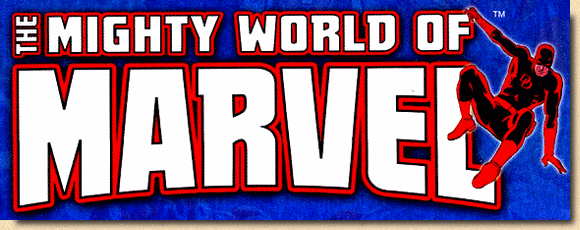
Reprinting
entire US issues in a monthly publication
cycle also did away with the need for
specially produced covers, splashpages,
editorial copy and - most importantly -
serialization. Which was probably just as
well, as a weekly title containing just a
few pages of today's decompressed
storytelling would leave most readers
stranded and without a clue as to how to
piece the weekly installments together.
|
|
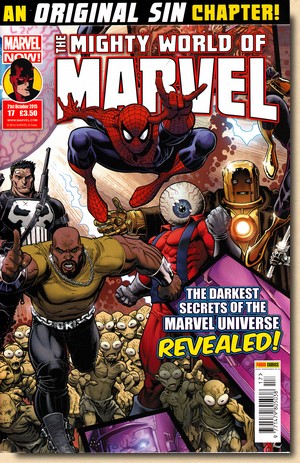
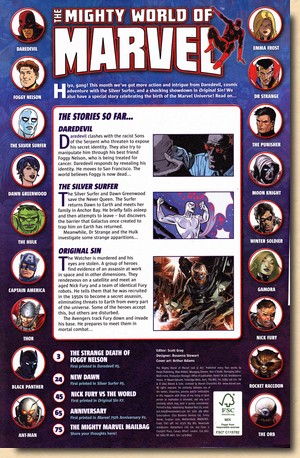
|
|
|
| |
|
| |
| BIBLIOGRAPHY BURK Kathleen
(1992) Goodbye, Great Britain: The 1976 IMF Crisis,
Yale University Press
KIRBY Rob (2013) "The Mighty
World of Marvel UK", in Back Issue #63,
April 2013
SANDERSON Peter (1998) Marvel
Universe, Abrams
WANNINSKI Jude
(1975) "Goodbye, Great Britain", The Wall Street
Journal (April 29 1975 issue)
|
| |
|
| |
 |
|
There's more on
the history of Marvel UK in the
1970s here. |
|
|
|
| |
 |
|
There are more
reviews of Marvel UK titles and
issues on this site, you can find
a list here. |
|
|
|
| |
|
| |
| |
First published
on the web 1 October 2015
updated and revised 25 August 2022
Text is copyright (c) 2015-2022

|
|
| |































